Science Short: Arctic Noise
Overview
Marine mammals, including those found in the Arctic, depend more on their hearing than other senses because sound travels well underwater. Bowhead whales; walrus; ringed, ribbon, and bearded seals; and other marine mammals rely on the sounds they make and hear to navigate, to contact one another, to court potential mates, to find food, and to avoid predators. The Arctic soundscape has long been shaped by their clicks and calls, as well as by wind, waves, and sea ice.
Today, the rapid loss of summer sea ice is opening this once largely inaccessible region to ship traffic, oil exploration, and other industrial activities. These changes mean the Arctic Ocean is becoming noisier—and that could have a profound impact on animals that rely on sound to survive.
This science brief looks at how anthropogenic—or man-made—sounds from ship engines, seismic surveys, and drilling machinery overlap with and may interfere with sounds produced and received by marine mammals. Studies show that whales, for example, respond to anthropogenic noise by leaving the area, reducing respiration or surface time, and decreasing calls to other whales. A study of northern right whales suggests they may be chronically stressed from high levels of sounds from ships. Additionally, collisions between animals and ships may result if the former are unable to locate and avoid the vessels because of masking, or interference created by the sounds of the ships.
Commercial development is a relatively new phenomenon in the Arctic, so many questions about the impacts of noise, particularly anthropogenic, on its marine ecosystem are still unanswered. Future research should be conducted and monitoring should be designed to assess the sensitivity of marine mammals to noise and to determine what can be done to reduce or mitigate the potential impact of anthropogenic noise.
Listen to the Sounds of the Arctic Ocean
| Bearded Seal | Ribbon Seal | Bowhead Whale | Beluga Whale | Walrus | Ice Cracking | Commercial Vessel | Airgun |
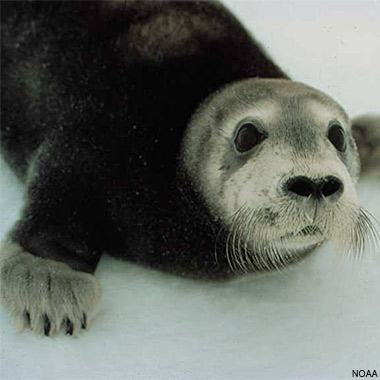 |
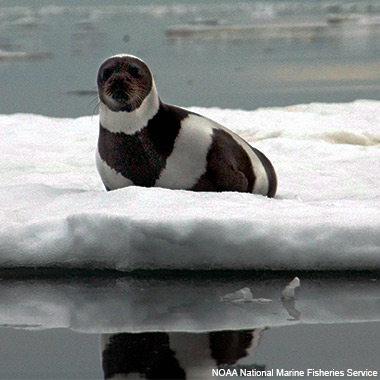 |
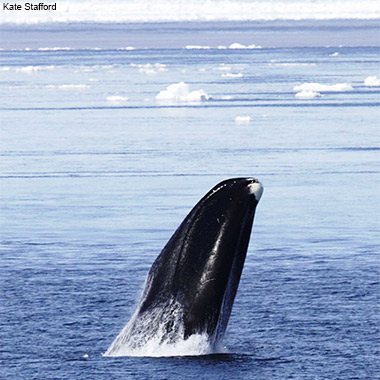 |
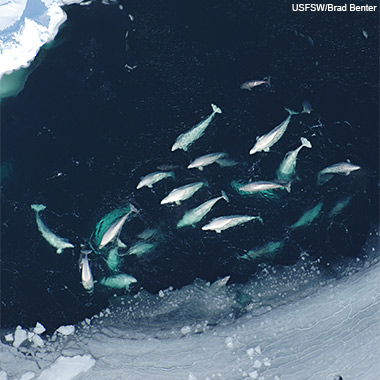 |
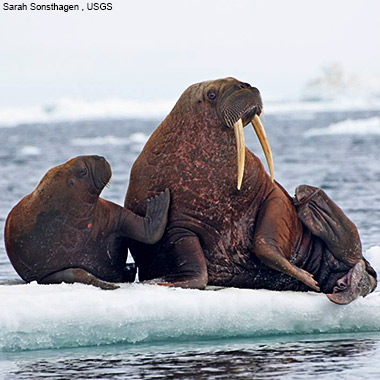 |
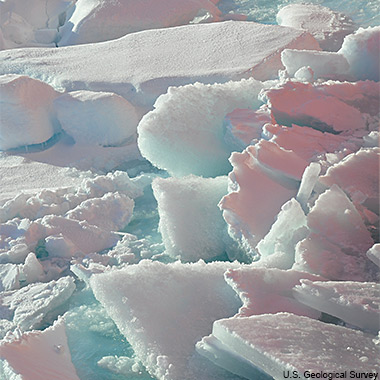 |
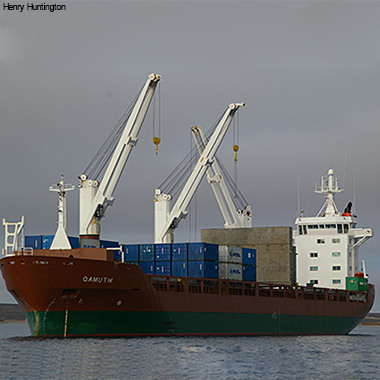 |
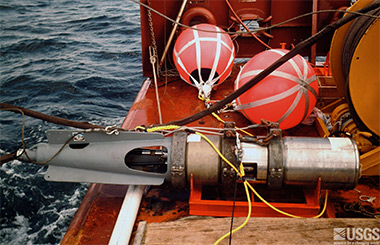 |
Key Terms
- Anthropogenic: man-made.
- Attenuation: the decrease in loudness or intensity of a sound.
- Decibel (dB): the unit used to measure how loud something is relative to a reference level of sound.
- Echolocation: a means of locating something by listening for the echo of a sound off that item. Bats and dolphins use echolocation to detect and find prey and to navigate.
- Frequency: the number of cycles of a sound wave per second measured in units of hertz, or Hz. A signal with few cycles per second is low frequency, and a signal with many cycles per second is higher frequency. Frequency might also be described as the pitch of a sound.
- Masking: interference from sound sources that reduces the ability to detect or locate sounds of interest.
- Mitigation: the attempt to reduce or eliminate the effects of anthropogenic sound on marine mammals when marine mammals are detected in areas where anthropogenic sound levels will be elevated.
Why is sound important to Arctic marine mammals?
Hearing is the most important sense for marine mammals. Light and scents do not travel far in the ocean and are useful only over short distances. Sound, meanwhile, travels extremely well underwater and can be heard for many miles by marine mammals. Both producing and hearing sounds are important to their survival.
In the Arctic, beluga whales and narwhals use echolocation clicks as sonar systems (similar to bats) to find food or navigate through their environment. Bowhead whales produce simple sounds to maintain contact with one another as they migrate in ice-covered waters. Ice seals, walrus, and bowhead whales produce elaborate acoustic mating displays that are likely vital to reproductive success. Marine mammals also listen for acoustic cues within their environment, including those produced by predators. They do all of this amid ambient (background) sound levels that come from natural (environmental) and anthropogenic (produced by human inputs) sources.
Sounds are classified by their frequency (or pitch). Humans can hear sounds from about 20 hertz, or Hz, to 20,000 hertz. Signals closer to 20 Hz, such as notes from an upright bass, are considered low frequency, while those closer to 20,000 Hz, such as notes from a piccolo, are high frequency. Human speaking voices produce sounds around 3,000 Hz, considered mid frequency.
As a group, marine mammals hear and produce sounds over a broader range of frequencies than do humans, with each species generally using quasi-specific frequency bands to communicate. For instance, bowhead whales produce sounds that are relatively low frequency (usually less than 1,000 Hz), bearded seals use mid frequencies (500 Hz to 6,000 Hz), and beluga whales produce sounds in high frequencies (from a few thousand hertz to more than 100,000 Hz).
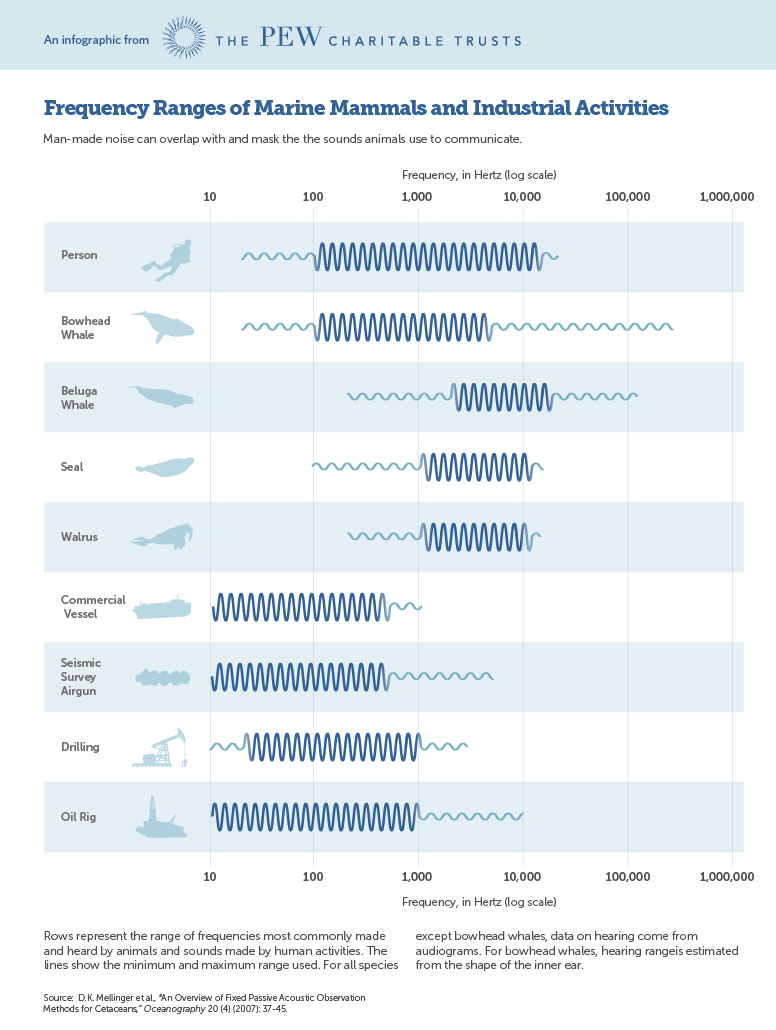
Natural soundscape in the Arctic
In the Arctic, the main sources of naturally occurring sounds include waves, winds, sea ice, and marine mammals. There is a direct correlation between increasing wind speeds and increasing ambient sound levels over open water. Sound levels tend to be higher for the same wind speed in shallow waters, such as those found in much of the nearshore Arctic, than in deep waters. Although the ice-covered Arctic can experience very low ambient sound levels due to the lack of wind-driven waves, the dynamics of sea ice, including ice formation and deformation, pressure ridging and cracking, can greatly increase ambient sound levels over a broad range of frequencies.
Lastly, marine mammals, particularly during the spring when many species produce elaborate vocal displays as part of mating behavior, can create such a chorus of sounds that it can be difficult for human listeners to distinguish individual animals or even species. This is a time of year when it may be especially important for animals to communicate with each other and when they may be most sensitive to increases in background sound.
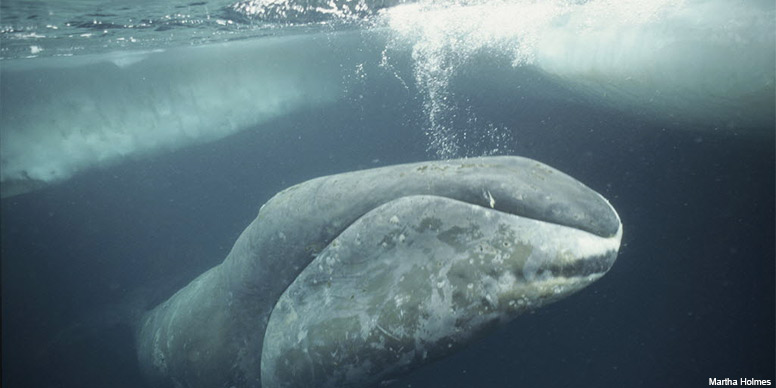
A bowhead whale swims underwater with sea ice visible behind it.
When does sound become noise?
Determining whether and how increases in ambient sound affect marine mammals and the severity of such impacts is extremely difficult. This is due, in part, to an incomplete understanding of marine mammal behavior. Adding to this difficulty is the lack of means or standardized methodologies to measure the effects of sound on animals.
When considering the potential for consequences of noise on marine species, both the frequency (pitch) and amplitude (loudness) of sound waves need to be considered. Sounds in the same range as those produced or heard by animals are considered more likely to affect them than sounds outside of their hearing range. This is because those sounds within the same range can interfere with signals that are important to animals, making it harder for them to hear each other or detect acoustic cues in the environment.
Loudness affects both how far away sound can be detected and whether it may cause temporary or longer-term hearing loss. Humans at a loud rock concert, for instance, may find standing next to a speaker to be almost painful or they may later experience ringing in their ears because the received level of sound is very high and within the frequency range at which human ears are most sensitive. The sound pressure levels exerted on the ear are directly proportional to the distance one is from the sound source. Sound travels much farther in water than in air, and low frequency sounds travel farther than higher frequency sounds. Therefore, the area of possible impact for low sounds can be very large.
Determining just how far a sound can be heard underwater and cause a reaction in marine mammals is very difficult, in part because researchers have an incomplete understanding of the hearing response of many marine mammals, particularly large whales. Determining whether they can hear certain signals, and how loud they have to be to be heard, is often based on the frequency range of signals they produce, their cochlear structure, and equivalent information from land-based mammals. Because seals and small whales such as belugas have been kept in captivity, we have a better understanding of their hearing abilities.
A second obstacle in documenting the impact of a sound on marine mammals stems from our inability to detect changes in behavior. Because sound travels much farther underwater than what we can measure in the air, visual observations from vessels may miss the potential effects on distant animals. Many marine mammal species spend more than 90 percent of their time underwater. That makes it difficult to document their responses to sounds that occur below the surface.
Finally, we still know very little about the ecology and behavior of most marine mammals. Unless an animal washes up on a beach with obvious signs of acoustic trauma, it is difficult to determine how exposure to underwater sounds impacts marine mammals on an individual or population-level scale.
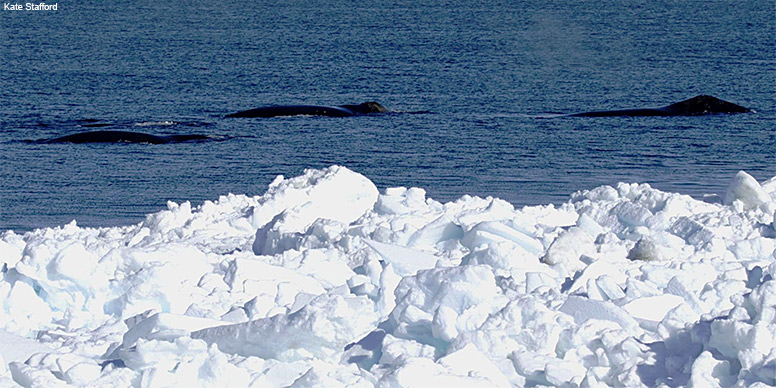
Four bowhead whales swim in a temporary opening in the sea ice, called a lead, just north of Barrow, Alaska.
What are the sources of anthropogenic sound in the Arctic?
Sources of anthropogenic sounds include seismic exploration using air guns for oil and gas and seafloor mapping, resource extraction (drilling), and ships, including small boats and larger tourism and commercial vessels. Most of these man-made sources of noise are relatively low frequency.
In the Arctic, these sounds overlap with many of the sounds produced and received by bowhead whales, walrus, and ringed, ribbon and bearded seals. Signals that overlap in frequency and amplitude with animal vocalizations are more likely to interfere with the animals' ability to hear sounds important to them. Low frequency sounds are more likely to be problematic for bowhead whales, mid frequencies for bearded seals, and high frequencies for beluga whales.
Air gun signals are low-frequency, impulsive sounds created by using compressed air to form bubbles. The formation of these bubbles creates loud sounds that penetrate the seafloor. The information from the return (via reflection and refraction) of the pulses is used to map the sea floor and profile the seabed to depths that may exceed 10 kilometers (6.2 miles). Pulses are generally produced from 10 to 40 seconds apart during surveys that last from hours to days. These signals can be detected over 1,000 kilometers (621 miles) away from the source and elevate noise levels even between pulses due to reverberation.
Drill ships are used by the oil and gas industry to explore areas that have been identified by air gun surveys as potentially rich in hydrocarbons. The signals from the rotating machinery used in drilling are generally low frequency (less than 1,000 Hz). These ships are seasonal floating oil and gas drilling structures deployed in the Arctic during the open water season (when northern oceans are largely free of sea ice). They return to port when sea ice begins to form in the fall. Because these ships operate around the clock, the sounds they produce are continuous and mostly stationary throughout the drilling season. Numerous supply and support vessels tend the drill ships throughout the open water season, resulting in associated sound sources that are mobile and often louder than sounds from the drill ship.
Ship traffic from icebreakers, research vessels, cargo ships, tankers, and tug and tow vessels is increasing in the Arctic. Large vessels produce continuous low-frequency noise (less than 1,000 Hz) primarily from the rotation of their propellers. In addition, local communities have long used small boats to hunt, fish, and move about in coastal and nearshore areas. These smaller vessels are usually equipped with outboard motors that produce higher-frequency noise than large ships.
All of these anthropogenic sources of sound are active primarily during summer and autumn when the Arctic is nearly free of sea ice. But exposure to these sounds is likely to increase over time as Arctic ice cover decreases. More vessels will be sailing in Arctic waters and will be operating for longer time periods. The exceptions to this are ice breakers (ships) and permanent drilling sites, such as the man-made Northstar Island that supports the Northstar drilling rig in the eastern Beaufort Sea, that operate even during heavy ice conditions.
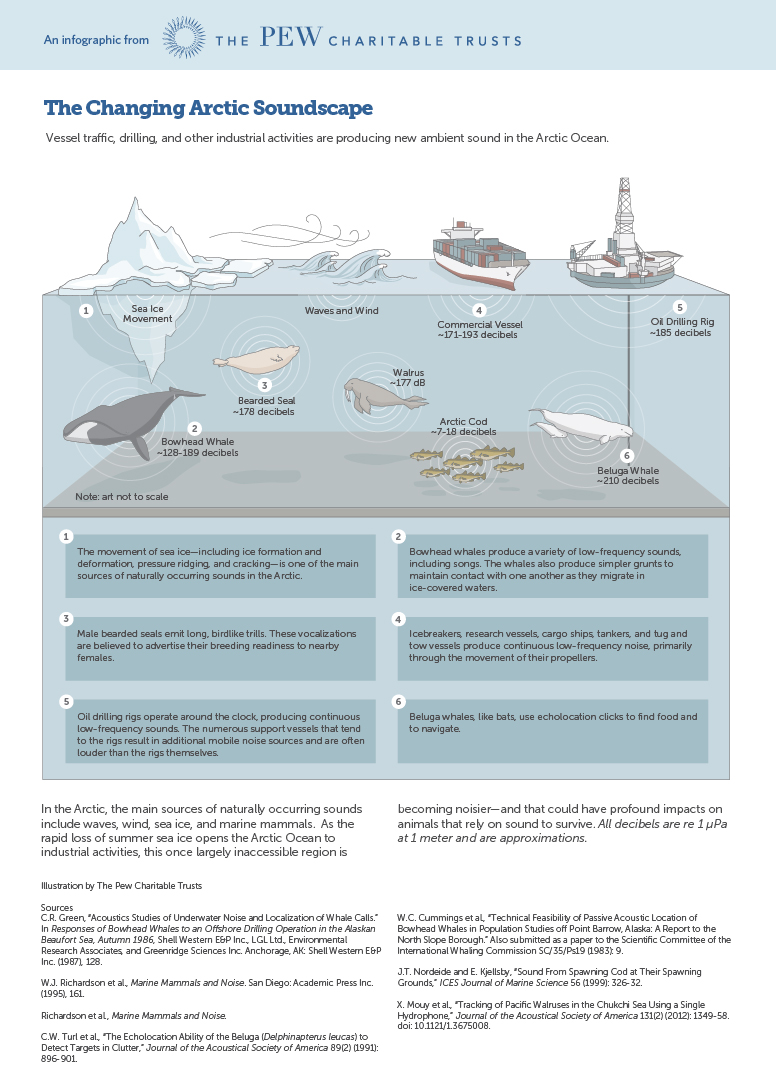
How does anthropogenic noise impact Arctic marine mammals?
Studies looking at changes in acoustic behavior of marine mammals and changes in environmental ambient sound levels typically rely on visual observations. But visual observations are limited to animals at the surface or within visual range, and to a limited number of behavioral cues, such as changes in swim speed or direction or changes in respiration rate.
The impact of seismic air gun pulses on bowhead whales has been the subject of numerous studies since the mid-1980s. Among the responses detected are the species leaving the area of seismic operations, reduced respiration or time at surface, and a decrease in calling to other whales. Beluga whales have been documented being deflected by ice breaker noise and leaving an area with active icebreaking and remaining away for as long as two days. For other Arctic marine mammals, such as ice seals, there are few studies on how underwater sound affects them.
Though commercial shipping in the Arctic is a relatively new phenomenon, studies from outside the Arctic have shown that during ship passages, the communication range of both baleen and some toothed whales is greatly reduced. And a recent study of northern right whales—a close relative of the bowhead whale—found that the decrease in low-frequency underwater sound due to the near cessation of ship traffic immediately after 9/11 was significantly correlated with a reduction in stress hormones in the whales. These data suggest that northern right whales, at least, may be chronically stressed from high levels of ship sound.
The response of an animal to sound is likely influenced by behavioral state, age, previous experience, individual hearing sensitivity, and sound tolerance as well as signal type. For instance, resting and migrating whales are more likely to respond to sound than are those engaged in social or feeding activities.
Animals also may respond more strongly to a sudden increase in sound versus a gradual increase. Because of these uncertainties, it is unknown if sound disturbances have long-lasting negative or population-scale consequences on marine mammals and this will be difficult to determine definitively. The reverse of this is also true: It remains equally difficult to demonstrate that these kinds of negative effects are not occurring. What is certain is that the underwater soundscape of the Arctic will grow louder for longer periods of time as the open water season increases and more ships ply these waters.
Additionally, collisions may result from marine mammals, most likely whales, being unable to locate and avoid ships because ships emit sounds over a wide range of frequencies and in all directions. At present only about 1 percent of bowhead whales show evidence of scarring from collisions with ships compared with about 7 percent of living North Atlantic right whales. Nearly 50 percent of recently documented mortalities for the latter species, whose habitat is exposed to higher levels of vessel traffic than that occurring in the Arctic Ocean, have been attributed to ship strikes. As shipping and vessel traffic in the U.S. Arctic Ocean is projected to increase noticeably, scientists will watch to see if evidence of strikes also increases.
Finally, Arctic marine mammals are migratory and long-lived. They may, therefore, be exposed to multiple sources of sound in an area during a season, over a year, and over a lifetime. Each single ship passage or seismic survey may have an impact on an animal, but the impact of all of these sources together—their cumulative impact—may be of greater concern.
How do you lessen the impact of sound on Arctic marine mammals?
Given the inevitability of increasing anthropogenic sound in the Arctic, what can be done to reduce or mitigate the potential impacts of man-made sound on marine mammals?
For the offshore oil and gas industry, those efforts can include a cessation of seismic and development activities during known periods when high concentrations of marine mammals are likely to be present. Another option would be to impose a sound “budget” to limit the amount of sound from industrial activities that can be conducted at one time. Mitigation also could include modifying or shutting down a sound when marine mammals are detected within a specified “zone of influence” or slowly increasing the volume of the sound source to provide animals the opportunity to leave the area before the loudest noises begin.
With regard to seismic air gun surveys, new mapping technologies may be available soon but are still considered unproven or too costly to replace air gun surveys. These technologies include marine virbroseis, which limits sound energy at frequencies above 100 Hz; the use of ambient sound sources such as wind, waves, and micro-earthquakes to image the subsea floor; or the use of bubble net curtains or other damping devices around air gun arrays to limit the horizontal transmission of sound. These technologies need to be investigated further, and exploration companies should be encouraged to continue developing means of reducing or quieting air guns in the Arctic. Reducing the number of simultaneous surveys or repeat surveys also will help to limit anthropogenic sound.
Mitigation efforts for the shipping industry and vessel traffic in general can include imposing speed limits, developing a standard for measuring radiated sound from vessels, and implementing quieting technologies on vessels to reduce sound in the environment. Although it would require considerable international cooperation, agreement on the location of shipping lanes and timing of transit could reduce ship strikes of marine mammals.
For instance, during their fall migration, the majority of western Arctic bowhead whales head south along the western side of Bering Strait in Russian territorial waters. Moving southbound shipping lanes to the eastern side of the strait in U.S. waters may be one way to reduce ship strike mortality for this population. Reducing shipping or moving shipping lanes and improving tracking of ships in the Arctic through the Automatic Identification System should permit a better understanding and reduction of the total amount of sound during important life history events, such as calving, mating, or feeding, or Alaska Native subsistence activities, such as coastal whaling.
Mitigation measures for both offshore oil and gas activities and shipping could include closing areas at specific times as well as permanent closures in areas with the highest ecological value or where species are most vulnerable. To minimize any impacts from industry-related activities, it is essential to first identify areas and times of year when marine animals may be most impacted by increases in anthropogenic sound.
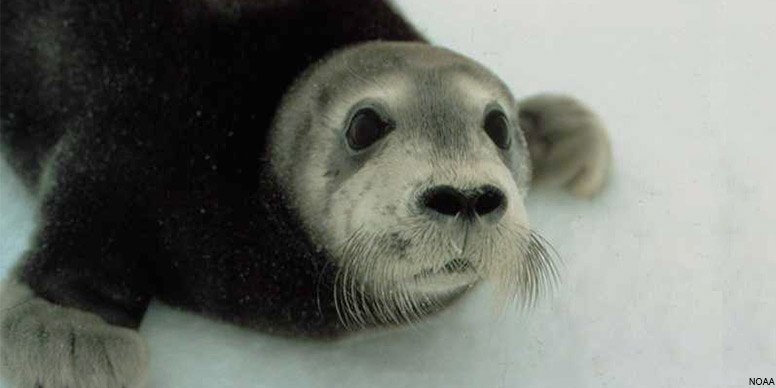
A young bearded seal on sea ice.
More research needed to understand impacts of noise on Arctic marine mammals
Many questions about Arctic marine mammals and the impacts of sound, particularly anthropogenic sound, in their ecosystem remain unanswered. Future research should be conducted and monitoring should be designed to better understand the sensitivity of marine mammals to noise. Future research might seek answers to the following questions:
- What is the best way to document the response of Arctic marine mammals to sound?
- In what areas and during what times of year are marine mammals most affected by anthropogenic increases in sound?
- What are the cumulative effects of increases in ambient sound levels for Arctic marine mammals?
- What effect does the decrease in seasonal ice cover have on ambient noise levels?
- Are there differences in responses to sound or its impacts on marine mammals specific to species, age, sex, or season?
- What are the most effective mitigation strategies for reducing potential impacts?
- What evidence is there of marine mammals being struck by vessels?
- What cumulative effects has noise in the marine ecosystem had on the ability of Alaskan Natives to successfully pursue subsistence practices?
About the Author
Dr. Kate Stafford is a principal oceanographer at the Applied Physics Laboratory at the University of Washington in Seattle. Using passive acoustics and other techniques, Stafford has been studying the sounds of whales for more than a decade. Her focus has been primarily on baleen whales in the North Pacific, but she has worked in, or with data from, all the world's oceans.






